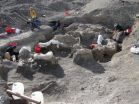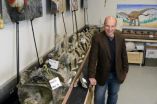(Press-News.org) This news release is available in Spanish.
PHILADELPHIA (September 4, 2014) – Scientists have discovered and described a new supermassive dinosaur species with the most complete skeleton ever found of its type. At 85 feet (26 m) long and weighing about 65 tons (59,300 kg) in life, Dreadnoughtus schrani is the largest land animal for which a body mass can be accurately calculated. Its skeleton is exceptionally complete, with over 70 percent of the bones, excluding the head, represented. Because all previously discovered supermassive dinosaurs are known only from relatively fragmentary remains, Dreadnoughtus offers an unprecedented window into the anatomy and biomechanics of the largest animals to ever walk the Earth.
"Dreadnoughtus schrani was astoundingly huge," said Kenneth Lacovara, PhD, an associate professor in Drexel University's College of Arts and Sciences, who discovered the Dreadnoughtus fossil skeleton in southern Patagonia in Argentina and led the excavation and analysis. "It weighed as much as a dozen African elephants or more than seven T. rex. Shockingly, skeletal evidence shows that when this 65-ton specimen died, it was not yet full grown. It is by far the best example we have of any of the most giant creatures to ever walk the planet."
Lacovara and colleagues published the detailed description of their discovery, defining the genus and species Dreadnoughtus schrani, in the journal Scientific Reports from the Nature Publishing Group today. The new dinosaur belongs to a group of large plant eaters known as titanosaurs. The fossil was unearthed over four field seasons from 2005 through 2009 by Lacovara and a team including Lucio M. Ibiricu, PhD, of the Centro Nacional Patagonico in Chubut, Argentina, the Carnegie Museum of Natural History's Matthew Lamanna, PhD, and Jason Poole of the Academy of Natural Sciences of Drexel University, as well as many current and former Drexel students and other collaborators.
Over 100 elements of the Dreadnoughtus skeleton are represented from the type specimen, including most of the vertebrae from the 30-foot-long tail, a neck vertebra with a diameter of over a yard, scapula, numerous ribs, toes, a claw, a small section of jaw and a single tooth, and, most notably for calculating the animal's mass, nearly all the bones from both forelimbs and hindlimbs including a femur over 6 feet tall and a humerus. A smaller individual with a less-complete skeleton was also unearthed at the site.
The 'gold standard' for calculating the mass of quadrupeds (four-legged animals) is based on measurements taken from the femur (thigh bone) and humerus (upper arm bone). Because the Dreadnoughtus type specimen includes both these bones, its weight can be estimated with confidence. Prior to the description of the 65-ton Dreadnoughtus schrani specimen, another Patagonian giant, Elaltitan, held the title of dinosaur with the greatest calculable weight at 47 tons, based on a recent study.
Overall, the Dreadnoughtus schrani type specimen's bones represent approximately 45.3 percent of the dinosaur's total skeleton, or up to 70.4 percent of the types of bones in its body, excluding the skull bones. This is far more complete than all previously discovered giant titanosaurian dinosaurs.
"Titanosaurs are a remarkable group of dinosaurs, with species ranging from the weight of a cow to the weight of a sperm whale or more. But the biggest titanosaurs have remained a mystery, because, in almost all cases, their fossils are very incomplete," said Matthew Lamanna.
For example, Argentinosaurus was of a comparable and perhaps greater mass than Dreadnoughtus, but is known from only a half dozen vertebrae in its mid-back, a shinbone and a few other fragmentary pieces; because the specimen lacks upper limb bones, there is no reliable method to calculate a definitive mass of Argentinosaurus. Futalognkosaurus was the most complete extremely massive titanosaur known prior to Dreadnoughtus, but that specimen lacks most limb bones, a tail and any part of its skull.
To better visualize the skeletal structure of Dreadnoughtus, Lacovara's team digitally scanned all of the bones from both dinosaur specimens. They have made a "virtual mount" of the skeleton that is now publicly available for download from the paper's open-access online supplement as a three-dimensional digital reconstruction.
"This has the advantage that it doesn't take physical space," Lacovara said. "These images can be ported around the world to other scientists and museums. The fidelity is perfect. It doesn't decay over time like bones do in a collection."
"Digital modeling is the wave of the future. It's only going to become more common in paleontology, especially for studies of giant dinosaurs such as Dreadnoughtus, where a single bone can weigh hundreds of pounds," said Lamanna.
The 3D laser scans of Dreadnoughtus show the deep, exquisitely preserved muscle attachment scars that can provide a wealth of information about the function and force of muscles that the animal had and where they attached to the skeleton – information that is lacking in many sauropods. Efforts to understand this dinosaur's body structure, growth rate, and biomechanics are ongoing areas of research within Lacovara's lab.
A Dinosaur that Feared Nothing
"With a body the size of a house, the weight of a herd of elephants, and a weaponized tail, Dreadnoughtus would have feared nothing," Lacovara said. "That evokes to me a class of turn-of-the-last century battleships called the dreadnoughts, which were huge, thickly clad and virtually impervious."
As a result, Lacovara chose the name "Dreadnoughtus," meaning "fears nothing." "I think it's time the herbivores get their due for being the toughest creatures in an environment," he said. The species name, "schrani," was chosen in honor of American entrepreneur Adam Schran, who provided support for the research.
To grow as large as Dreadnoughtus, a dinosaur would have to eat massive quantities of plants. "Imagine a life-long obsession with eating," Lacovara said, describing the potential lifestyle of Dreadnoughtus, which lived approximately 77 million years ago in a temperate forest at the southern tip of South America.
"Every day is about taking in enough calories to nourish this house-sized body. I imagine their day consists largely of standing in one place," Lacovara said. "You have this 37-foot-long neck balanced by a 30-foot-long tail in the back. Without moving your legs, you have access to a giant feeding envelope of trees and fern leaves. You spend an hour or so clearing out this patch that has thousands of calories in it, and then you take three steps over to the right and spend the next hour clearing out that patch."
An adult Dreadnoughtus was likely too large to fear any predators, but it would have still been a target for scavengers after dying of natural causes or environmental disasters. Lacovara's team discovered a few teeth from theropods – smaller predatory and scavenging dinosaurs– among the Dreadnoughtus fossils. However, the completeness and articulated nature of the two skeletons are evidence that these individuals were buried in sediments rapidly before their bodies fully decomposed. Based on the sedimentary deposits at the site, Lacovara said "these two animals were buried quickly after a river flooded and broke through its natural levee, turning the ground into something like quicksand. The rapid and deep burial of the Dreadnoughtus type specimen accounts for its extraordinary completeness. Its misfortune was our luck."
INFORMATION:
Link to paper (on and after Sept. 4, 2014): http://dx.doi.org/10.1038/srep06196
Primary collaborators on the study with Lacovara were Matthew C. Lamanna, PhD of the Carnegie Museum of Natural History in Pittsburgh and Lucio M. Ibiricu, PhD of the Centro Nacional Patagonico in Chubut, Argentina, who began working with Lacovara as an undergraduate volunteer during the Dreadnoughtus excavation and went on to earn his doctoral degree at Drexel University. Lamanna was first author on a recent paper describing the dinosaur Anzu wyliei, popularly known as the "chicken from Hell."
Additional co-authors are: Jason C. Poole, Dinosaur Hall Coordinator at the Academy of Natural Sciences of Drexel University; Elena R. Schroeter, PhD, who recently earned her doctoral degree for her work on Dreadnoughtus in Lacovara's lab at Drexel; Paul V. Ullmann, Kristyn K. Voegele and Zachary M. Boles, doctoral candidates in Lacovara's lab at Drexel; Aja M. Carter, a 2014 Drexel environmental science alumna who contributed to Dreadnoughtus preparation as an undergraduate; Emma K. Fowler, an undergraduate Drexel student; Victoria M. Egerton, PhD of the University of Manchester, who earned her doctoral degree in Lacovara's lab; Alison E. Moyer, a 2008 Drexel alumna who was part of the Dreadnoughtus excavation in Argentina as an undergraduate and is now a doctoral candidate in paleontology at North Carolina State University; Christopher L. Coughenour, PhD, who earned his doctoral degree in Lacovara's lab at Drexel and is now at the University of Pittsburgh, Johnstown, PA. campus; Jason P. Schein of the New Jersey State Museum; Jerald D. Harris, PhD, of Dixie State College in St. George, Utah; Ruben D. Martínez, PhD of the Universidad Nacional de la Patagonia San Juan Bosco in Chubut, Argentina; and Fernando E. Novas, PhD, of the Museo Argentino de Ciencias Naturales in Buenos Aires.
Lacovara, Lamanna and Poole were previously among the co-authors describing Paralititan stromeri, a large titanosaur which they excavated from the Egyptian Sahara.
Under Argentinian law, the Dreadnoughtus fossils are the property of the federal government in Argentina and are to be retained permanently in the province where they were discovered, Santa Cruz. The fossils were transported to Philadelphia and Pittsburgh in 2009 for scientific preparation and analysis under a research loan agreement. Fossil preparation and analysis occurred at Drexel University, the Academy of Natural Sciences of Drexel University and the Carnegie Museum of Natural History. All Dreadnoughtus fossils are currently at Drexel University and will be returned to their permanent repository at the Museo Padre Molina in Rio Gallegos, Argentina, in 2015.
Funding sources for the study of Dreadnoughtus include the National Science Foundation (EAR Award 0603805 and three Graduate Research Fellowships [DGE Award 1002809]), the Jurassic Foundation, R. Seidel, Drexel University, The Academy of Natural Sciences of Drexel University, Carnegie Museum of Natural History, and supporting donor Adam Schran.
Drexel team unveils Dreadnoughtus: A gigantic, exceptionally complete sauropod dinosaur
Largest land animal for which mass can be accurately calculated
2014-09-04
ELSE PRESS RELEASES FROM THIS DATE:
Phase III FIRST™ (MM-020/IFM 07-01) trial of REVLIMID® (lenalidomide) plus dexamethasone in newly diagnosed multiple myeloma patients who are not candidates for stem cell transplant published in New E
2014-09-04
SUMMIT, N.J. (Sept. 4, 2014) – Celgene Corporation (NASDAQ:CELG) today announced that data from FIRST (MM-020/IFM 07-01)—an open-label phase III randomized study of continuous REVLIMID (lenalidomide) in combination with dexamethasone in patients newly diagnosed with multiple myeloma (NDMM) who are not candidates for stem cell transplant—have been published in the Sept. 4 issue of the New England Journal of Medicine.
Initial findings, including that the trial had met its primary endpoint of progression free survival (PFS), were reported during the plenary session at the ...
Nano-pea pod model widens electronics applications
2014-09-04
New York | Heidelberg, 4 September 2014 -- Periodic chain-like nanostructures are widely used in nanoelectronics. Typically, chain elements include the likes of quantum rings, quantum dots, or quantum graphs. Such a structure enables electrons to move along the chain, in theory, indefinitely. The trouble is that some applications require localised electrons—these are no longer in a continuous energy spectrum but in a discrete energy spectrum, instead. Now, a new study by Russian scientists identifies ways of disturbing the periodicity of a model nanostructure to obtain ...
Speaking of chemistry: Rethinking football head injuries (video)
2014-09-04
WASHINGTON, Sept. 4, 2014 — Football season is here, and along with thousands of lost hours of productivity from fantasy teams, there's a renewed discussion on the impact of head injuries on players. This week's Speaking of Chemistry focuses on a brain disorder called chronic traumatic encephalopathy (CTE), whose symptoms include memory loss, depression and aggressive or violent behavior. Current detection methods can only identify CTE after a patient has died, leaving many NFL players with a diagnosis that came too late. Now doctors are developing a way to spot CTE in ...
Titania-based material holds promise as new insulator for superconductors
2014-09-04
Research from North Carolina State University shows that a type of modified titania, or titanium dioxide, holds promise as an electrical insulator for superconducting magnets, allowing heat to dissipate while preserving the electrical paths along which current flows. Superconducting magnets are being investigated for use in next-generation power generating technologies and medical devices.
Regular conductors conduct electricity, but a small fraction of that energy is lost during transmission. Superconductors can handle much higher currents per square centimeter and lose ...
Normal-weight counselors feel more successful at helping obese patients slim
2014-09-04
A new study by researchers at the Johns Hopkins Bloomberg School of Public Health suggests that normal-weight nutrition and exercise counselors report feeling significantly more successful in getting their obese patients to lose weight than those who are overweight or obese.
A report on the findings, published online Sept. 4 in the journal Obesity, suggests that patients may be more receptive to those who "practice what they preach."
"Our research shows that the personal weight of health professionals matters when assessing their perceived level of success in helping ...
Breast conserving therapy shows survival benefit compared to mastectomy in early-stage patients
2014-09-04
When factoring in what is now known about breast cancer biology and heterogeneity, breast conserving therapy (BCT) may offer a greater survival benefit over mastectomy to women with early stage, hormone-receptor positive disease, according to research from The University of Texas MD Anderson Cancer Center.
The study findings defy the conventional belief that the two treatment interventions offer equal survival, and show the need to revisit some standards of breast cancer practice in the modern era.
The research was presented at the 2014 Breast Cancer Symposium by ...
Disparities persist in early-stage breast cancer treatment, MD Anderson study finds
2014-09-04
Despite its acceptance as standard of care for early stage breast cancer almost 25 years ago, barriers still exist that preclude patients from receiving breast conserving therapy (BCT), with some still opting for a mastectomy, according to research from The University of Texas MD Anderson Cancer Center.
The study, to be presented at the 2014 Breast Cancer Symposium, finds that those barriers that still exist are socio-economic, rather than medically-influenced. Meeghan Lautner, M.D., formerly a fellow at MD Anderson, now at The University of Texas San Antonio, will present ...
AIBS analysis of peer review offers insights into research productivity
2014-09-04
RESTON, VA – In a paper published today in the journal PLOS One, investigators with the American Institute of Biological Sciences report findings from an analysis of the research output from a series of biomedical research grants funded after undergoing a scientific peer review process. The results, reported in 'The Validation of Peer Review Through Research Impact Measures and the Implications for Funding Strategies,' offer insights for future research on peer review and potential models for increasing research productivity.
"Some form of peer review is used at the ...
Breast vs. bottle feeding in rhesus monkeys
2014-09-04
(SACRAMENTO, Calif.) — Infant rhesus monkeys receiving different diets early in life develop distinct immune systems that persist months after weaning, a study by researchers from UC Davis, the California National Primate Research Center (CNPRC) at UC Davis and UC San Francisco have shown. The study, which compares breast- and bottle-fed infants, appears online September 3 in Science Translational Medicine.
While the researchers expected different diets would promote different intestinal bacteria (microbiota), they were surprised at how dramatically these microbes shaped ...
Liver injury caused by herbals, dietary supplements rises in study population
2014-09-04
New research shows that liver injury caused by herbals and dietary supplements increased from 7% to 20% in a U.S. study group over a ten-year period. According to the study published in Hepatology, a journal of the American Association for the Study of Liver Diseases, liver injury caused by non-bodybuilding supplements is most severe, occurring more often in middle-aged women and more frequently resulting in death or the need for transplantation than liver injury from bodybuilding supplements or conventional medications."
Nearly half of all adult Americans consume herbal ...
LAST 30 PRESS RELEASES:
Why nail-biting, procrastination and other self-sabotaging behaviors are rooted in survival instincts
Regional variations in mechanical properties of porcine leptomeninges
Artificial empathy in therapy and healthcare: advancements in interpersonal interaction technologies
Why some brains switch gears more efficiently than others
UVA’s Jundong Li wins ICDM’S 2025 Tao Li Award for data mining, machine learning
UVA’s low-power, high-performance computer power player Mircea Stan earns National Academy of Inventors fellowship
Not playing by the rules: USU researcher explores filamentous algae dynamics in rivers
Do our body clocks influence our risk of dementia?
Anthropologists offer new evidence of bipedalism in long-debated fossil discovery
Safer receipt paper from wood
Dosage-sensitive genes suggest no whole-genome duplications in ancestral angiosperm
First ancient human herpesvirus genomes document their deep history with humans
Why Some Bacteria Survive Antibiotics and How to Stop Them - New study reveals that bacteria can survive antibiotic treatment through two fundamentally different “shutdown modes”
UCLA study links scar healing to dangerous placenta condition
CHANGE-seq-BE finds off-target changes in the genome from base editors
The Journal of Nuclear Medicine Ahead-of-Print Tip Sheet: January 2, 2026
Delayed or absent first dose of measles, mumps, and rubella vaccination
Trends in US preterm birth rates by household income and race and ethnicity
Study identifies potential biomarker linked to progression and brain inflammation in multiple sclerosis
Many mothers in Norway do not show up for postnatal check-ups
Researchers want to find out why quick clay is so unstable
Superradiant spins show teamwork at the quantum scale
Cleveland Clinic Research links tumor bacteria to immunotherapy resistance in head and neck cancer
First Editorial of 2026: Resisting AI slop
Joint ground- and space-based observations reveal Saturn-mass rogue planet
Inheritable genetic variant offers protection against blood cancer risk and progression
Pigs settled Pacific islands alongside early human voyagers
A Coral reef’s daily pulse reshapes microbes in surrounding waters
EAST Tokamak experiments exceed plasma density limit, offering new approach to fusion ignition
Groundbreaking discovery reveals Africa’s oldest cremation pyre and complex ritual practices
[Press-News.org] Drexel team unveils Dreadnoughtus: A gigantic, exceptionally complete sauropod dinosaurLargest land animal for which mass can be accurately calculated






